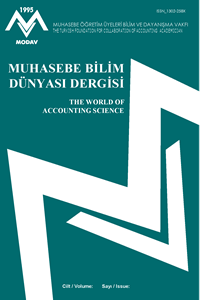THE CONSENSUS AMONG US GAAP AND IFRS HAVING STEMMED FROM PRESSURE OF THE U.S. SOFTWARE INDUSTRY: “APPLE RULES”
Öz
In the last ten years, software companies enter into more complex service offerings, so-called ―“multiple deliverables”. This study describes how Apple Inc. found itself in the center of subscription accounting rules in US GAAP causing an understatement of its iPhone earnings by $3.8 billion in 2008 and then primarily took the leading role in pushing Financial Accounting Standards Board (FASB) for a need of standard change in that particular industry, started in 2008 and finalized in 2014. On September 23, 2009, the industry gained its first victory against Generally Accepted Accounting Principles (US GAAP) with the issuance of new rules; Emerging Issues Task Force (EITF) Issue No. 08-1, “Revenue Arrangements with Multiple Deliverables” (EITF 08-1) and then penetrated the whole industry in the world with a converged standard; namely “Revenue from Contracts with Customers” (IFRS 15) which was issued jointly by FASB and International Accounting Standards Board (IASB) on May 28, 2014 superseding all FASB’s and IASB’s rules.
Anahtar Kelimeler
IFRS 15 revenue multiple-deliverables Apple subscription accounting
Kaynakça
- Blodget, H. 2009. “iPhone Accounting Change Could Send Apple Profits And Stock To Moon”, www.businessinsider.com/henry-blodget-new-apple-iphone-accounting-change-could-send-profits-and-stock-to-moon-2009-9 (Access Date: 20.02.2016).
- Bowen, R. and Kennedy, J. 2010. “The iPhone Revenue Bomb”, http://faculty.washington.edu/rbowen/cases/Apple%20Revenue%20Rec%20Strategy%20(B)_10-10.pdf (Access Date: 18.03.2016).
- Brochet, F., Palepu, K. and Barley, L. 2013. “Accounting for the iPhone at Apple Inc.”, www.hbs.com (Access Date: 18.02.2016).
- DeWitt, P. 2009. “Spotlight on Apple’s Hidden Revenue Stream”, http://fortune.com/2009/01/20/spotlight-on-apples-hidden-revenue-stream/ (Access Date: 18.03.2016).
- Dilger, D. 2009. “Inside Apple’s iPhone Subscription Accounting Changes”, http://appleinsider.com/articles/09/10/21/inside_apples_iphone_subscription_accounting_changes (Access Date: 18.03.2016).
- FASB, 2008. “EITF 08-01: Revenue Arrangements with Multiple Deliverables”.
- FASB, 2008. “EITF 00-21: Revenue Arrangements with Multiple Deliverables”.
- IASB, 2014. “IFRS 15: Revenue from Contracts with Customers” http://www.iasplus.com (Access Date: 24.03.2016).
- KPMG, 2009. “Implementing the New EITF Consensuses on Multiple Element Revenue Arrangements”, https://www.kpmg.com/Ca/en/topics/Quarterly-Update/Documents/fn_iid09-03.pdf (Access Date: 18.02.2016).
- Leone, M. 2009. "New Revenue-Recognition Rules: The Apple of Apple’s Eye?" http://ww2.cfo.com/accounting-tax/2009/09/new-revenue-recognition-rules-the-apple-of-apples-eye/ (Access Date: 18.02.2016).
- PWC, 2015. “IFRS and US GAAP: Similarities and Differences”, http://www.pwc.com (Access Date: 24.03.2016).
- SOP 97-2: Software Revenue Recognition, 1997.
- www.apple.com
- www.fasb.org
- www.forbes.com
- www.inc.com
- www.samsung.com
- www.bpmcpa.com
ABD YAZILIM ENDÜSTRİSİNDEN MUHASEBE DEĞİŞİKLİĞİ İÇİN GELEN BASKI KAYNAKLI US GAAP ve UFRS UZLAŞMASI: “APPLE KURALLARI”
Öz
Yazılım şirketleri, özellikle son on yılda, “çoklu eylem içeren sözleşmeler” niteliğindeki daha karmaşık hizmet sunumuna girmiştir. Bu çalışmada, finansal tablolarını Amerikan Genel Kabul Görmüş Muhasebe İlkeleri’ne (US GAAP) göre hazırlayan Apple Şirketi’nin abonelik muhasebesi kurallarına uyum nedeniyle 2008 yılında gerçekleştirdiği iPhone satışlarına ilişkin hasılat tutarını 3,8 milyar dolar az göstermek zorunda kaldığı ve bu nedenle ABD Finansal Muhasebe Standartları Kurulu'nun bir standart değişikliğine gitmesinde piyasada üstlendiği öncü rolü anlatılmıştır. 23 Eylül 2009’da, hızla büyüyen bu endüstri, ilk önce Gündeme Gelen Çalışma Grubu’nun (Emerging Issues Task Force-EITF) yayınladığı EITF 08-1 “Çoklu Eylem İçeren Sözleşmelere İlişkin Hasılat” ile US GAAP’in gerçeği yansıtmayan eski uygulamasına karşı ilk zaferini kazanmış ve daha sonra uzun süren çalışmalar neticesinde, 28 Mayıs 2014’te ABD Finansal Muhasebe Standartları Kurulu ve Uluslararası Muhasebe Standartları Kurulu (UMSK) tarafından ortak UFRS 15 “ Müşterilerle Yapılan Sözleşmelerden Doğan Hasılat” Standardı yayınlanmıştır.
Anahtar Kelimeler
IFRS 15 hasılat çoklu eylem içeren sözleşmeler Apple üyelik muhasebesi
Kaynakça
- Blodget, H. 2009. “iPhone Accounting Change Could Send Apple Profits And Stock To Moon”, www.businessinsider.com/henry-blodget-new-apple-iphone-accounting-change-could-send-profits-and-stock-to-moon-2009-9 (Access Date: 20.02.2016).
- Bowen, R. and Kennedy, J. 2010. “The iPhone Revenue Bomb”, http://faculty.washington.edu/rbowen/cases/Apple%20Revenue%20Rec%20Strategy%20(B)_10-10.pdf (Access Date: 18.03.2016).
- Brochet, F., Palepu, K. and Barley, L. 2013. “Accounting for the iPhone at Apple Inc.”, www.hbs.com (Access Date: 18.02.2016).
- DeWitt, P. 2009. “Spotlight on Apple’s Hidden Revenue Stream”, http://fortune.com/2009/01/20/spotlight-on-apples-hidden-revenue-stream/ (Access Date: 18.03.2016).
- Dilger, D. 2009. “Inside Apple’s iPhone Subscription Accounting Changes”, http://appleinsider.com/articles/09/10/21/inside_apples_iphone_subscription_accounting_changes (Access Date: 18.03.2016).
- FASB, 2008. “EITF 08-01: Revenue Arrangements with Multiple Deliverables”.
- FASB, 2008. “EITF 00-21: Revenue Arrangements with Multiple Deliverables”.
- IASB, 2014. “IFRS 15: Revenue from Contracts with Customers” http://www.iasplus.com (Access Date: 24.03.2016).
- KPMG, 2009. “Implementing the New EITF Consensuses on Multiple Element Revenue Arrangements”, https://www.kpmg.com/Ca/en/topics/Quarterly-Update/Documents/fn_iid09-03.pdf (Access Date: 18.02.2016).
- Leone, M. 2009. "New Revenue-Recognition Rules: The Apple of Apple’s Eye?" http://ww2.cfo.com/accounting-tax/2009/09/new-revenue-recognition-rules-the-apple-of-apples-eye/ (Access Date: 18.02.2016).
- PWC, 2015. “IFRS and US GAAP: Similarities and Differences”, http://www.pwc.com (Access Date: 24.03.2016).
- SOP 97-2: Software Revenue Recognition, 1997.
- www.apple.com
- www.fasb.org
- www.forbes.com
- www.inc.com
- www.samsung.com
- www.bpmcpa.com
Ayrıntılar
| Birincil Dil | İngilizce |
|---|---|
| Konular | İşletme |
| Bölüm | ANABÖLÜM |
| Yazarlar | |
| Yayımlanma Tarihi | 30 Mart 2017 |
| Gönderilme Tarihi | 20 Ocak 2017 |
| Yayımlandığı Sayı | Yıl 2017 Cilt: 19 Sayı: 1 |
Yazarlık
MBDD, araştırma makalelerine yapılan katkıların adil şekilde tanınmasını sağlamak amacıyla COPE Yazarlık Kılavuzuna uymaktadır (https://publicationethics.org/guidance/discussion-document/authorship). Yazarlık, hem hak hem de sorumluluk taşır; bu nedenle, listelenen tüm yazarların araştırmaya önemli katkılarda bulunmuş olması gerekmektedir.
Birden fazla yazarlı çalışmalarda, Yazar Katkıları bölümü, sonuç bölümünden sonra ve kaynakçadan önce yer almalıdır. Makalenin hangi bölümlerine hangi yazarın katkı sağladığını belirtmek için yazarların isim baş harfleri ve soyadları kullanılmalıdır. Detaylı bilgiye "Makale Gönderim Kontrol Listesi" düğmesine tıklayarak ulaşılabilir. Ayrıca, yazarlar, yazarlık kriterlerini karşılamayan ancak çalışmaya katkı sağlayan kişileri teşekkür bölümünde belirtebilirler.
Yazarlar araştırmanın tasarım ve uygulanmasında üretilen Yapay Zekâ (YZ) ve YZ destekli araçların kullanımını açıklamak zorundadırlar. Bu tür kullanımlar, makalenin yöntem bölümünde belirtilmelidir. YZ kullanımının belirtilmesi, makalenin yayımlanmasını engellemez; aksine, araştırmanın şeffaf bir şekilde sunulmasını sağlar.


